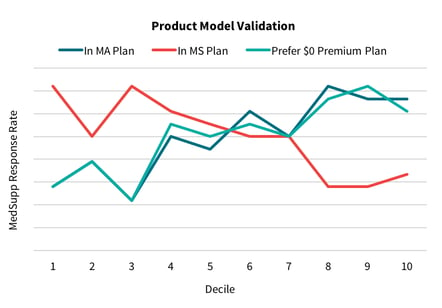Over the past four years, Deft Research has aggregated shopping, switching, and member experience data from over 50,000 Individual Medicare consumers through our Senior Market Intelligence Service. We have integrated this robust data asset with geographic market data and third party marketing data to produce a set of Medicare member acquisition models.
The models are designed to enhance health plan’s marketing lists by providing insights about Individual Medicare consumers all along the sales process, including their:
- product preferences
- channel behaviors
- likelihood to enroll or disenroll
TESTING THE MODELS
To test their strength, one of the nation’s leading healthcare-focused direct marketing agencies applied our product propensity models against Medicare marketing results from the previous year’s AEP. They used lift charts and decile tables to measure the performance of the models against what the results were when they did not use the models.
The chart above shows the response rates of individuals who are currently enrolled in a MedSupp plan broken out by “In MA Plan” and “In MedSupp Plan”. As you can see, there is a clear negative correlation between the “in MA plan” and the “in MedSupp plan” scores. What this tells you is that Deft Research’s propensity models successfully identified which product consumers were likely to be enrolled in.
The agency indicated that the other Medicare Advantage and MedSupp propensity models available to them tended to be direct response models first, with a slight alteration for product. Deft Research’s acquisition models are based on actual insurance type membership – making them true product propensity models.
The models can help marketers to:
- Develop very precise, targeted campaigns.
- Align the right product offers to the right consumers.
- Convert prospects into customers.
- Reduce marketing expenses.
- Increase campaign profitability.
Editor's Note: This post was originally published May 17, 2016 and has been updated for accuracy and comprehensiveness.
Complete the form below to find out more about how predictive modeling can work for your organization.

